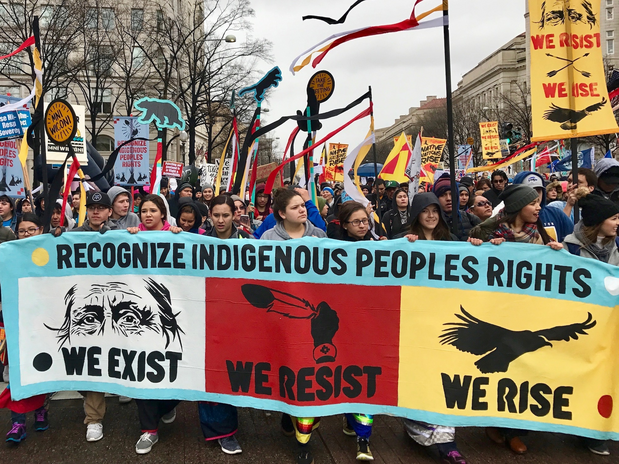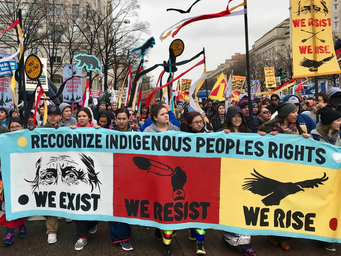Editor’s Note: Taylor Orcutt is a non-Indigenous journalism student and Indigenous media research assistant at Ohio University. She is also a non-Indigenous Associate member of the Indigenous Journalists Association, IJA (formerly known as the Native American Journalists Association, NAJA). While she has worked closely with Indigenous media and issues academically, she encourages readers to seek information on Indigenous Peoples’ Day directly from different Indigenous media sources and tribal websites. This article is intended to be a starting point for individual education, as Indigenous Peoples’ Day is celebrated in a multitude of ways by over 600 federally and state-recognized tribes, and even more organizations. This article is not comprehensive.
Observed on the second Monday of October, Indigenous Peoples’ Day is a national commemoration of the millions of Indigenous peoples who have inhabited North America “since time immemorial.” The day may ring familiar to Americans; the second Monday of October is formerly known as Columbus Day.
Some states still observe Columbus Day. However, on October 8, 2021, President Biden signed a proclamation to nationally replace Columbus Day with Indigenous Peoples’ Day.
“Today, we acknowledge the significant sacrifices made by Native peoples to this country — and recognize their many ongoing contributions to our Nation.”
“A Proclamation on Indigenous Peoples’ Day, 2021” – President Biden, The White House
“A Proclamation on Indigenous Peoples’ Day, 2021.” President Biden, The White House
The proclamation was a culmination of decades of protest and advocacy by Indigenous groups nationwide. Indigenous peoples have fought for change since the 1977 International Conference on Discrimination Against Indigenous Populations in the Americas, where the idea was proposed, according to Native News Online.
Between 1977 and 2021, states and cities began to observe Indigenous Peoples’ Day. South Dakota, with one of the highest Indigenous populations in the country, was the first state to recognize Indigenous Peoples’ Day in 1990, according to Native News Online and CNN. The first U.S. cities to observe the day were Berkeley and Santa Cruz, CA in 1992 and 1994 respectively. This year, 30 states observe Indigenous Peoples’ Day, with Maine, Nebraska, New Mexico, and the District of Columbia recognizing it as a state holiday, according to timeanddate.com.
Mainstream media commonly discusses Indigenous people and issues through the hardships or suffering those communities face, citing chronic illness, disease, or addiction; COVID-19 impacts, historical trauma, and mourning. These topics are important to recognize but are often dwelled upon negatively without the insights of Indigenous people. Furthermore, these issues are viewed from a colonized perspective and are worsened by current patterns of colonization. Often, the mainstream media overlooks the generational strength, cultural resilience, community, perseverance, wisdom, ways of knowing, and joy that are ingrained in the Indigenous experience. This is reflected on Indigenous Peoples’ Day, as well.
“The day is one of celebration, reflection and recognition that Indigenous communities are fighting for land rights, for the U.S. government to uphold treaties, and for visibility and understanding.”
“Indigenous Peoples Day marked with celebrations, protests.” The Associated Press, republished in The Cherokee Phoenix, 2021.
Indigenous Peoples’ Day is not a simple celebration. The day is about more than Indigenous trauma. It is about educating on Indigenous political and socioeconomic issues, such as water rights, landback, and tribal sovereignty. It is about more representative, less antiquated historical discussions of Indigenous peoples. It is about holding the U.S. accountable for upholding treaties. It is about justice for Indigenous peoples.
“You know, people have silenced the Indigenous people’s voice for so long.”
“Mashpee Wampanoag Tribe Chairman: Indigenous Peoples’ Day is ‘Essential’.” Chairman Brian Weeden of the Mashpee Wampanoag Tribe in interview with Kathryn Eident for CAI, 2022.
On Indigenous Peoples’ Day, people can show support in several ways, and it’s important to continue that support throughout the year. Most importantly, supporters should take the time to educate themselves on the day and reflect on the perspectives of Indigenous communities. Supporters can do this by reading articles by Indigenous media sources, such as the Cherokee Phoenix, the Navajo Times, Indian Country Today, Tribal Business News, or news by Indigenous journalists in mainstream organizations. Consider joining the newsletters of Indigenous news sources to support year-round. Search out interviews by tribal members and elders, such as the interview cited above. Also, search for social media posts from Indigenous creators. Better yet, talk to someone Indigenous personally to learn about their experiences (but don’t burden them as your only source of information. That is not their job).
Supporters can also consider contributing financially to Indigenous groups if they have the means to. This could look like supporting some of the media sources above, donating to non-profit causes, or purchasing products from Indigenous-owned-and-operated businesses (there are many). However, pulling out the wallet isn’t the only step. Supporters should take the time to learn about the mission and work of the media organizations or non-profits they choose to support. If a supporter chooses to purchase, for example, a blanket from a Diné (Navajo) weaver or seamstress, take the time to learn about the significance of the pattern, materials, and process to Diné history, tradition, and culture. If it is a local artist, take the time to talk to them about how they learned their craft and developed their creative process. Support cannot be passive.
Finally, many local events nationwide are happening today to celebrate and recognize Indigenous Peoples’ Day. If there is one in your area (which can be found online via a Google search), consider attending to show support and engage with a local organization or tribe.


